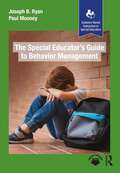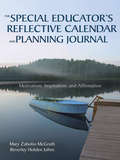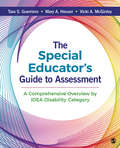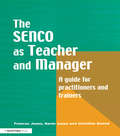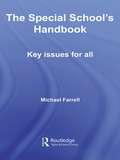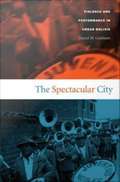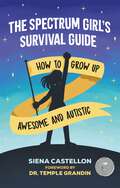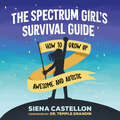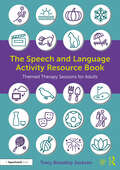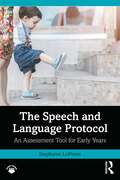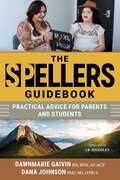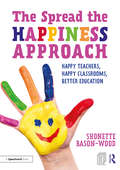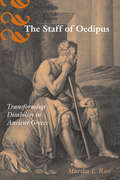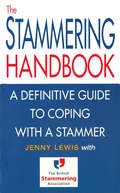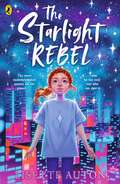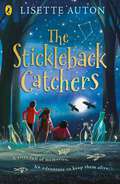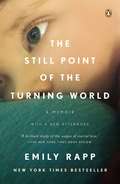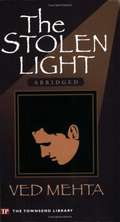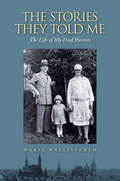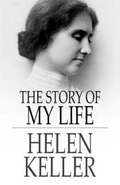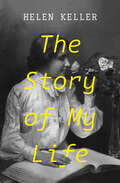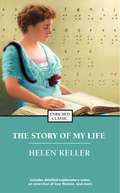- Table View
- List View
The Special Educator’s Guide to Behavior Management (Evidence-Based Instruction in Special Education)
by Paul Mooney Joseph B. RyanThis accessible, practitioner-focused textbook details a comprehensive classroom behavior management framework that is easy to understand and implement within a K-12 classroom. Influenced by decades of classroom teaching and special education teacher candidate preparation experiences, the book features effective evidence-based strategies designed to both prevent problem behaviors from occurring in classrooms and address challenging behaviors that presently exist or may arise.Each of the book’s four sections show readers step-by-step how to develop, implement, and evaluate a personalized behavior management plan that best meets the unique needs of their classrooms which can vary tremendously in both size and types of students served. From the first page to the last, this new text addresses the reader in a friendly, personal way in an effort to enhance accessibility and encourage them to want to understand the "what and how" of each strategy and/or process and how it relates to the overall behavioral framework laid out in section one.Ideal for both current and prospective special educators, this book supports readers in developing their own comprehensive approach to classroom behavior management that can be implemented across grade levels.
The Special Educator’s Reflective Calendar and Planning Journal: Motivation, Inspiration, and Affirmation
by Beverley H. Johns Mary Zabolio McgrathSpecial educators can go from August to July with this resource's tips, space for daily to-do lists, and reflective prompts on collaboration, working with parents, writing IEPs, and more.
The Special Educator′s Guide to Assessment: A Comprehensive Overview by IDEA Disability Category
by Tara S. Guerriero Mary A Houser Vicki A. McGinleySpecial education students often learn about the characteristics of disabilities, but can lack an understanding of the relationship between diagnostic assessment and eligibility for special education services. The Special Educator′s Guide to Assessment: A Comprehensive Overview by IDEA Disability Category focuses on the role that assessment plays in the diagnosis of a disability, determination of eligibility for special education services, and education of students with disabilities to provide a meaningful interconnection between assessment concepts and classroom application for teachers. Authors Tara S. Guerriero, Mary A. Houser, and Vicki A. McGinley want to ensure that future special education teachers have the preparation to provide comprehensive instruction to P-12 students through this text. While special education teachers are often not the ones conducting comprehensive evaluations, it is paramount that they understand their students’ individual characteristics, and understand how assessment is used to determine diagnosis and eligibility. Framing the text around The Individuals with Disabilities Act (IDEA) provides students with concrete standards by which all disabilities are evaluated and regulated in our public educational system. Part I introduces the basic topics of assessment, ethics, and assessment types. Part II moves on to provide diagnostic and eligibility criteria according to IDEA categories that are most commonly diagnosed in an educational setting while Part III describes the criteria for IDEA categories most commonly diagnosed in a medical setting. Features like case studies and sample comprehensive evaluations help bring to life assessment and how it applies in real classrooms. Included with this title: The password-protected Instructor Resource Site (formally known as SAGE Edge) offers access to all text-specific resources, including a test bank and editable, chapter-specific PowerPoint® slides.
The Special Educator′s Guide to Assessment: A Comprehensive Overview by IDEA Disability Category
by Tara S. Guerriero Mary A Houser Vicki A. McGinleySpecial education students often learn about the characteristics of disabilities, but can lack an understanding of the relationship between diagnostic assessment and eligibility for special education services. The Special Educator′s Guide to Assessment: A Comprehensive Overview by IDEA Disability Category focuses on the role that assessment plays in the diagnosis of a disability, determination of eligibility for special education services, and education of students with disabilities to provide a meaningful interconnection between assessment concepts and classroom application for teachers. Authors Tara S. Guerriero, Mary A. Houser, and Vicki A. McGinley want to ensure that future special education teachers have the preparation to provide comprehensive instruction to P-12 students through this text. While special education teachers are often not the ones conducting comprehensive evaluations, it is paramount that they understand their students’ individual characteristics, and understand how assessment is used to determine diagnosis and eligibility. Framing the text around The Individuals with Disabilities Act (IDEA) provides students with concrete standards by which all disabilities are evaluated and regulated in our public educational system. Part I introduces the basic topics of assessment, ethics, and assessment types. Part II moves on to provide diagnostic and eligibility criteria according to IDEA categories that are most commonly diagnosed in an educational setting while Part III describes the criteria for IDEA categories most commonly diagnosed in a medical setting. Features like case studies and sample comprehensive evaluations help bring to life assessment and how it applies in real classrooms. Included with this title: The password-protected Instructor Resource Site (formally known as SAGE Edge) offers access to all text-specific resources, including a test bank and editable, chapter-specific PowerPoint® slides.
The Special Needs Coordinator as Teacher and Manager: A Guide for Practitioners and Trainers
by Kevin Jones Frances Jones Christine SzwedThis text reflects the shift in the SENCO's role from SEN teacher to manager. Written within the context of the most recent government initiatives, it can be used by both special-needs coordinators and by special-educational-needs trainers and advisory staff. In two parts, it explores the range of skills required for the role of special needs coordinator and offers information and advice to develop those skills. Practical activities enable the user to monitor and evaluate special-needs provision in their own school and to implement a structured process of change in partnership with all those involved in meeting special educational needs.
The Special School's Handbook: Key Issues for All (nasen spotlight)
by Michael FarrellGiving an up-to-date picture of the work of special schools, this practical and informative book provides an invaluable and timely companion for anyone teaching or planning to teach in special schools in the United Kingdom. Using case studies of good practice to provide clear suggestions on how special schools may be further developed, the wide-ranging chapters address topics such as: adapting the curriculum to give special schools more flexibility implications of Every Child Matters and multi-professional working organisational changes in special schools the changing roles of staff in the modern special school ways of assessing the progress and achievement of pupils working with parents. With a no-nonsense, non-academic approach, and with each chapter featuring think points and suggestion for further study, The Special School's Handbook contains a wealth of invaluable information, resources and advice and is a handy reference book which staff can dip in and out of at their leisure.
The Spectacular City: Violence and Performance in Urban Bolivia
by Daniel M. GoldsteinSince the Bolivian revolution in 1952, migrants have come to the city of Cochabamba, seeking opportunity and relief from rural poverty. They have settled in barrios on the city's outskirts only to find that the rights of citizens--basic rights of property and security, especially protection from crime--are not available to them. In this ethnography, Daniel M. Goldstein considers the significance of and similarities between two kinds of spectacles--street festivals and the vigilante lynching of criminals--as they are performed in the Cochabamba barrio of Villa Pagador. By examining folkloric festivals and vigilante violence within the same analytical framework, Goldstein shows how marginalized urban migrants, shut out of the city and neglected by the state, use performance to assert their national belonging and to express their grievances against the inadequacies of the state's official legal order. During the period of Goldstein's fieldwork in Villa Pagador in the mid-1990s, residents attempted to lynch several thieves and attacked the police who tried to intervene. Since that time, there have been hundreds of lynchings in the poor barrios surrounding Cochabamba. Goldstein presents the lynchings of thieves as a form of horrific performance, with elements of critique and political action that echo those of local festivals. He explores the consequences and implications of extralegal violence for human rights and the rule of law in the contemporary Andes. In rich detail, he provides an in-depth look at the development of Villa Pagador and of the larger metropolitan area of Cochabamba, illuminating a contemporary Andean city from both microethnographic and macrohistorical perspectives. Focusing on indigenous peoples' experiences of urban life and their attempts to manage their sociopolitical status within the broader context of neoliberal capitalism and political decentralization, The Spectacular City highlights the deep connections between performance, law, violence, and the state.
The Spectrum Girl's Survival Guide: How to Grow Up Awesome and Autistic
by Siena Castellon"Never be ashamed of being different: it is this difference that makes you extraordinary and unique." This essential go-to guide gives you all the advice and tools you'll need to help you flourish and achieve what you want in life. From the answers to everyday questions such as 'Am I using appropriate body language?' and 'Did I say the wrong thing?', through to discussing the importance of understanding your emotions, looking after your physical and mental health and coping with anxiety and sensory overloads, award-winning neurodiversity campaigner Siena Castellon uses her own experiences to provide you with the skills to overcome any challenge. With practical tips on friendships, dating, body image, consent and appearance, as well as how to survive school and bullying, The Spectrum Girl's Survival Guide gives you the power to embrace who you are, reminding you that even during the toughest of teen moments, you are never alone.
The Spectrum Girl's Survival Guide: How to Grow Up Awesome and Autistic
by Siena Castellon"Never be ashamed of being different: it is this difference that makes you extraordinary and unique." This essential go-to guide gives you all the advice and tools you'll need to help you flourish and achieve what you want in life. From the answers to everyday questions such as 'Am I using appropriate body language?' and 'Did I say the wrong thing?', through to discussing the importance of understanding your emotions, looking after your physical and mental health and coping with anxiety and sensory overloads, award-winning neurodiversity campaigner Siena Castellon uses her own experiences to provide you with the skills to overcome any challenge. With practical tips on friendships, dating, body image, consent and appearance, as well as how to survive school and bullying, The Spectrum Girl's Survival Guide gives you the power to embrace who you are, reminding you that even during the toughest of teen moments, you are never alone.(P) 2020 Hodder & Stoughton Ltd
The Speech and Language Activity Resource Book: Themed Therapy Sessions for Adults
by Tracy Broadley JacksonThe Speech and Language Activity Resource Book offers a flexible and readily available set of activities and worksheets designed to support speech and language therapists as they deliver personalised and engaging therapy sessions. With topics based on seasons, hobbies, sports and celebrations, etc, the worksheets can be selected to suit a client’s interests as well as targeting specific skills and needs. The engaging activities encourage conversation and participation, promoting skill development in a way that is easily translated into everyday communication. Key features of this book include: A range of activities, arranged by level of difficulty, that can be selected based on the client’s individual need A person-centred approach to therapy, enabling the time-poor practitioner the opportunity to personalise their care with ease Photocopiable and downloadable sheets that can be completed during therapy sessions or sent out to the client for home practice, as well as blank worksheets that can be used to create new, appropriate activities Easily adaptable for group sessions, one-on-one therapy sessions and home activities, this is an essential tool for speech and language therapists and occupational therapists, as well as families and other practitioners supporting adults with a range of acquired communication difficulties.
The Speech and Language Protocol: An Assessment Tool for Early Years
by Stephanie LoPrestiThis valuable book addresses the common problems faced by speech‑language pathologists, offering solutions and strategies for more effective service delivery.Stephanie LoPresti introduces ‘The Protocol,’ a child development‑based approach that merges principles from developmental psychology and speech‑language pathology. The book covers a wide range of speech and language issues, including receptive, expressive, pragmatic, feeding, and play development, making it a versatile resource for clinicians. It is designed to be easy to use, with movable elements that adapt to a child’s progress from short‑ to long‑term milestones and goals. It emphasizes the concept of the zone of proximal development, ensuring that clinicians work with clients just above their current level of functioning, leading to meaningful progress.Accompanied by downloadable worksheets to assess progress, it will be an essential resource for all speech and language pathologists, particularly those working with young children. It will also be useful to students and educators in the field of speech‑language pathology seeking evidence‑based strategies for working with clients, as well as healthcare professionals, researchers, and educators interested in child development and language acquisition.
The Spellers Guidebook: Practical Advice for Parents and Students
by Dana Johnson Dawnmarie GaivinA means by which thousands, and soon millions, of people are being freed from their lives of silence. The Spellers Guidebook is the first of its kind—a comprehensive guidebook that every family should take along for their Spelling journey. From the moment you first learn about spelled communication through working with a practitioner, developing fluency, and everything in between, this book serves as a blueprint to follow while you build the skills to spell openly with your child. The Spellers Guidebook is informative not only for parents and caregivers but for practitioners and professionals as well. It answers questions from the most basic—what to expect during the first spelling session, to more clinical—what is apraxia, and how does it affect my speller? It even discusses the importance of regulation and how the interpersonal dynamic between the speller and their communication partner can impact flow. The journey toward open communication differs for every family, and this handbook is here to help remove any guesswork. Whether your path seems straight and easy to navigate or the road ahead appears winding and twisting, Dana and DM are here to guide you. If you walk away with nothing more than the confidence that you can do this with your nonspeaker (because you CAN), The Spellers Guidebook has done its job!
The Spread the Happiness Approach: Happy Teachers, Happy Classrooms, Better Education
by Shonette Bason-WoodBoth practical and inspiring, this book is designed to empower educators and school leaders to make clear and simple adjustments to their practice for a lasting impact on the happiness and well- being of staff and children and ultimately on academic standards. It includes practical tips and activities to help teachers generate a lasting atmosphere of positivity and happiness in the classroom plus clear strategies to help leaders to embed the Spread the Happiness approach throughout their school and across the curriculum.This book includes detailed case studies, a five-week programme of taster challenges and a section on measuring outcomes and sharing success. The Spread the Happiness approach invites teachers to undertake a 27-day challenge, which encourages problem solving and challenges them to make their immediate workplace happier. It identifies the strengths of adults and children and sets realistic goals to achieve as an individual, as a team and even as a community.This powerful resource will be of great interest to all teachers and school leaders, as well as trainee teachers and students on leadership or early educational courses.
The Staff of Oedipus: Transforming Disability in Ancient Greece
by Rose Martha L.Ancient Greek images of disability permeate the Western consciousness: Homer, Teiresias, and Oedipus immediately come to mind. But The Staff of Oedipus looks at disability in the ancient world through the lens of disability studies, and reveals that our interpretations of disability in the ancient world are often skewed. These false assumptions in turn lend weight to modern-day discriminatory attitudes toward disability. Martha Rose considers a range of disabilities and the narratives surrounding them. She examines not only ancient literature, but also papyrus, skeletal material, inscriptions, sculpture, and painting, and draws upon modern work, including autobiographies of people with disabilities, medical research, and theoretical work in disability studies. Her study uncovers the realities of daily life for people with disabilities in ancient Greece, and challenges the translation of the termadunatos(unable) as "disabled," with all its modern associations. Martha Rose is Associate Professor of History, Truman State University.
The Stammering Handbook: A Definitive Guide to Coping With a Stammer
by Jenny LewisMany people regard stammering as a joke, reinforced by the fact that they are usually portrayed on film and television as figures of fun: Michael Palin in a Fish Called Wanda, Ronnie Barker in Open All Hours. But for those who stammer - and there are half a million in Britain -the affliction is a constant source of misery and embarrassment. The Stammering Handbook aims to help stammerers of all ages cope with it in everyday life - at work, at home, at school, at play. It will be illustrated with case histories and contains advice and help for friends and relations, too. Fully endorsed by and written with the help of The British Stammering Association, THE STAMMERING HANDBOOK is essential reading.
The Starlight Rebel: Perfect for readers aged 9+, a thrilling and big-hearted sci-fi adventure set in Earth's distant future!
by Lisette AutonA sci-fi adventure full of heart - perfect for fans of Ross Welford!In the future, the most underestimated person on the planet may be the only one who can save it.The year is 3897, and life on Earth is a neon dream, all flashing lights and buzzy noise – and no one remembers that behind the illuminated shell above them there's a night sky filled with stars.As she turns 11, neurodivergent, freckled Astrifer Nova is nothing like her sporty, high-achieving twin brother, Blaze. And on the day of her Work Path Allocation ceremony which determines the course of her life, she is crushed when she gets assigned to something as boring as the sock factory.But all is not as it seems, and as she uncovers layers of hidden truths all around her, Astrifer discovers that the world is bigger than she ever imagined – and that it’s up to her and a motley crew of new friends (including one from very far away) to challenge the status quo. Turns out, their differences may be exactly what the planet needs…
The Stickleback Catchers
by Lisette Auton'A magic realist fight to save a beloved grandmother from dementia . . . dialect, disability, neurodivergence and gender-nonconformity were all woven incidentally into this open-hearted book - Guardian Best Children's Books of 2023Mimi adores her wild, fun, full-of-life gran. Then Gran starts forgetting things. Suddenly there are cracks appearing all around their home - and a mysterious black crow - both of which only Mimi seems able to see.Mimi is determined to solve the mystery. Luckily she has new friends to help: Titch and Nusrat. Together, they're the Stickleback Catchers: solvers of puzzles and seekers of adventure.Down by the river, where the gang meet and the silvery sticklebacks swim, they discover a mysterious stone, speckled with stars. But this is no ordinary stone: it's the doorway to another world, a world of talking crows and secrets, magical constellations and memories - and maybe, just maybe, Mimi's chance to bring back Gran forever...
The Still Point of the Turning World
by Emily RappTHE NEW YORK TIMES BESTSELLER With a new chapter detailing the events that have taken place since Ronan's passing in February 2013. Like all mothers, Emily Rapp had ambitious plans for her son, Ronan. He would be smart, loyal, physically fearless, level-headed but fun. He would be good at crossword puzzles like his father. He would be an avid skier like his mother. Rapp would speak to him in foreign languages and give him the best education. But all of these plans changed when Ronan was diagnosed at nine months old with Tay-Sachs disease, a rare and always-fatal degenerative disorder. Ronan was not expected to live beyond the age of three; he would be permanently stalled at a developmental level of six months. Rapp and her husband were forced to re-evaluate everything they thought they knew about raising a family. They would have to learn to live with their child in the moment; to find happiness in the midst of sorrow; to parent without a future. The Still Point of the Turning World is the story of a mother's journey through grief and beyond it. Rapp's response to her son's diagnosis was a belief that she needed to 'make my world big' - to make sense of her family's situation through art, literature, philosophy, theology and myth. Drawing on a broad range of thinkers and writers, from C. S. Lewis to Sylvia Plath, Hegel to Mary Shelley's Frankenstein, Rapp learns what wisdom there is to be gained from parenting a terminally ill child. In luminous, exquisitely moving prose, she re-examines our most fundamental assumptions about what it means to be a good parent, to be a success, and to live a meaningful life.
The Stolen Gods
by Jake PageBowdre, a powerfully built wildlife sculptor, is blind, which doesn't stop him from pursuing the truth when trouble erupts in the art world of Santa Fe.
The Stolen Light
by Ved MehtaThe author recounts his experiences as a blind college student, and tells how he came to write his first book.
The Stories They Told Me: The Life of My Deaf Parents
by Cornelia Wallisfurth Maria WallisfurthIn this heartfelt memoir, Maria Wallisfurth recounts the lives of her deaf parents in Germany from the turn of the twentieth century through the 1930s. Her mother, Maria Giefer, was born in 1897 and her father, Wilhelm Sistermann, was born in 1896. The author captures the seasonal rhythms and family life of her mother’s youth in rural Germany, a time filled as much with hardship as it is with love. When she is old enough, she moves to the nearby city of Aachen to attend a school for deaf children, where she learns to lipread and speak. After her schooling is complete, she returns home to work on the family farm and experiences the privations and fear that accompany World War I. She later goes back to Aachen, where she joins a deaf club and falls in love with Wilhelm, a painter and photographer who was raised in the city. Amidst high unemployment, food shortages, and rapid inflation, the two are married in 1925 and two years later the author is born. Under the Nazi regime, Maria and Wilhelm are ordered to undergo forced sterilization. Although their deafness is not hereditary and they submit applications of protest, they are compelled to comply with the law. Despite their dissimilar backgrounds and the political circumstances that roiled their lives, the author’s parents showed great love for each other and their only daughter. The Stories They Told Me is a richly detailed document of time and place and a rare account of deaf lives during this era.
The Story of Esther Costello
by Nicholas MonsarratEsther Costello, born on a peasant farm in Ireland, became a deaf-blind-mute after an explosion. She was discovered and saved from her predicament by Mrs. Bannister, a wealthy American. Mrs. Bannister rescued her, and brought her to Boston shortly after the 2nd World War. Mrs. Bannister taught Esther how to communicate by writing letters in her palm. Esther became an overnight success in America and around the world. Then in walks Mr. Bannister, the separated husband, but interested in how Esther can be used as a money-making machine. What happens to Esther and the Bannisters?
The Story of My Life: With Her Letters (1887-1901) And A Supplementary Account Of Her Education, Including Passages From The Reports And Letters Of Her Teacher, Anne Mansfield Sullivan, By John Albert Macy
by Helen KellerA classic of American autobiography—the remarkable story of Helen Keller&’s early life and education At nineteen months old, Helen Keller was stricken with a mysterious illness that left her deaf and blind. For the next five years, she was trapped in the silent dark, her only means of communication a few dozen rudimentary signs. Her inability to express herself was a great source of frustration, and as she grew older, Helen became prone to angry outbursts and fits of despair. Her family sought help, and in March of 1887, twenty-year-old Anne Sullivan arrived from the Perkins Institution for the Blind. One month later, teacher and student made the first of many incredible breakthroughs. By placing one of Helen&’s hands under cool running water and tracing the letters w-a-t-e-r on her other hand, Anne was able to convey the great mystery of language: that every object has a name. As Helen would later write in The Story of My Life, &“That living word awakened my soul.&” Covering the first twenty-two years of Helen Keller&’s life, from that miraculous moment at the water pump to her acceptance into Radcliffe College, The Story of My Life is one of the most beloved and inspiring autobiographies ever written. The basis for The Miracle Worker, the Tony Award–winning play and Academy Award–winning film, its heartening message has touched millions of lives and torn down countless barriers the world over. This ebook has been professionally proofread to ensure accuracy and readability on all devices.
The Story of My Life: With Her Letters And A Supplementary Account Of Her Education (Enriched Classics)
by Helen KellerEnriched Classics offer readers accessible editions of great works of literature enhanced by helpful notes and commentary. Each book includes educational tools alongside the text, enabling students and readers alike to gain a deeper and more developed understanding of the writer and their work.Left blind, deaf, and mute after an illness in infancy, Helen Keller overcame her disabilities with the help of Anne Sullivan, her inspired teacher. Her classic autobiography, first published in 1903, covers her first twenty-two years, including the memorable moment at a water pump when she first made the connection between the word "water" and the cold liquid flowing over her hand. She also discusses her friendships with Oliver Wendell Holmes and other notables, her education at Radcliffe, her joy at learning to speak, and above all, her extraordinary relationship with her teacher. This deeply moving memoir, full of love and compassion for others, offers an unforgettable portrait of one of the twentieth century's most remarkable women. Enriched Classics enhance your engagement by introducing and explaining the historical and cultural significance of the work, the author's personal history, and what impact this book had on subsequent scholarship. Each book includes discussion questions that help clarify and reinforce major themes and reading recommendations for further research. Read with confidence.
